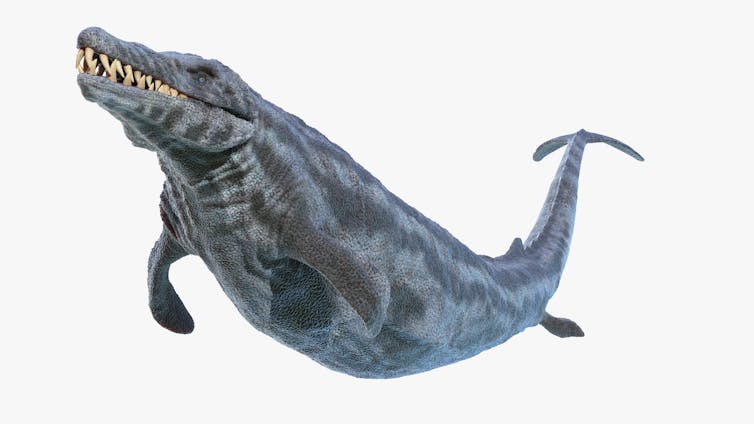
People often think of all whales as giants of the sea when in fact they vary in size dramatically, from the 30-metre blue whale to the two-metre dwarf sperm whale. However, almost all of the largest family by size, the baleen whales, are massive – and scientists have only recently understood how they grew so big.
Adding to this understanding, a new study may help explain a longstanding puzzle in science about how baleen whales can have such a high cell reproduction rate without succumbing to cancer – a problem known as “Peto’s Paradox”.
The Australian researchers analysed a dataset of baleen whale genes and found that two of the largest species, blue and fin whales, have genes associated with a powerful immune system. Genes linked to survival and longevity were also found in all baleen species.
Baleen whales evolved bristly baleen plates instead of teeth, which filter or trap krill, plankton and small fish inside their mouths. The 14 baleen species include the rorqual family – slender, streamlined baleen whales such as fin, sei, humpback and the largest animal that has ever lived, the blue whale.
Rorquals swim large distances which has made uncovering their evolution difficult for many reasons, including that it’s harder to identify individual populations. Furthermore, the scale of commercial hunting in the past two centuries almost destroyed many rorqual populations.
The Australian study builds on recent genetic studies as well as studies from evolutionary biology, marine biology and animal behaviour that have given us a clearer picture about where rorquals’ evolution diverged, and how that made them grow giant.
A landmark study published in 2023 sequenced the genome of the rarely seen pygmy right whale, the smallest of the living baleen whales which makes it an interesting comparison with the large rorquals. The paper suggested the molecular mechanisms of rorquals seem to give them cancer resistance.
Another 2023 genetic study helped us understand how hybridisation muddled the picture of their genomic makeup, as there has been much interbreeding between rorqual species. But we now know that rorquals took a different ecological and evolutionary niche to other baleen whales, as well as toothed whales, to become impressive hunters.
The ancestors of whales
The land-based, hippo-like predecessors of whales moved slowly to aquatic life. But a 2019 study showed that genes lost during this process helped these animals adapt to life diving deep underwater. For example, the loss of one gene reduced the risk of lung inflammation from diving.
Studies comparing the genomes of different species have changed our understanding of rorqual size, with the humpback, blue and minke whale genomes all recently having been sequenced and compared.
Five genes stand out as different to smaller species (as well as certain DNA sequences that can enhance or switch on genes). These genes have been linked elsewhere to gigantism in whale sharks as well as larger species of fish and land carnivores.
We know from fossil studies the ancient animals that would become whales, Basilosaurus, started to radiate out further into the water 40 million years ago and began to dominate the ocean.

Initially, they ate sedimentary creatures from the bottom of the sea and rivers, as grey whales do today. Later (30-34 million years ago), those whale ancestors that went further into the sea fed on energy-rich, slow-moving prey that lived in large groups.
We know the ancestors of right whales stayed close to the shore. But the rorquals splintered off separately about 10.5 million years ago after feeding further out to sea.
They had little competition for this new and abundant food source, and quickly developed in size and speed. Rorquals’ distinctive characteristics such as their throat grooves, pointed head and streamlined bodies developed independently. Given the size that rorquals gained from dominating the sea early on, they faced few predators.
Right whales vs rorquals
Right whales are shorter, rotund baleen whales compared with the slender bodies of rorquals. Due to their closer social lives, shorter migrations and more passive filter feeding, the right whales had little need for faster movement and have developed an ideal shape for a relaxed life. As such they are large, fat and slow, and their genomes are revealing new information for comparison with their more slender, faster cousins – for example, that whale hunting led to inbreeding and low genetic diversity among right whales.
In contrast, rorquals make long, lonelier migrations and feed through lunge feeding. This involves accelerating forwards with a closed mouth before opening the mouth wide, then filtering the water out through their baleen plates. The dynamics of lunge feeding give prey further out in the ocean little hope whether they are krill, plankton, or shoals of small fish.
Throat grooves running from the rorquals’ mouth to underbelly expand to allow in prey and large amounts of water. The throat grooves expand because of their large, flexible nerves which can recoil and stretch, allowing rorquals to engulf water of a larger volume than their own body size.
This morphology enabled rorquals to grow much larger, feed on greater numbers of more diverse prey, and travel faster to the best feeding grounds. They are a prime example of nature’s success when given a new corner of the environment, energy-rich prey, no borders, and no predators.
Sam McKee, Associate Tutor and PhD Candidate in Philosophy of Science, Manchester Metropolitan University
This article is republished from The Conversation under a Creative Commons license. Read the original article.











